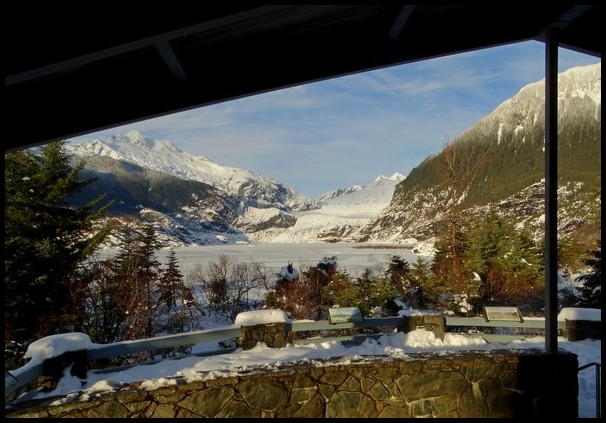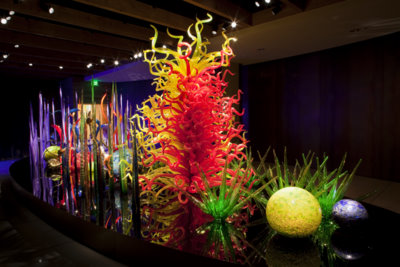
All About Mendenhall Glacier in Alaska
Beautiful Mendenhall Glacier lies just 12 miles outside downtown Juneau, Alaska. It’s deservedly one of Juneau’s main draws.
This glacier boasts many superlatives. It’s the most-easily-accessible glacier in Alaska and the only SE Alaskan glacier accessible by road. That, in turn, has made Mendenhall one of Alaska’s most famous and most visited glaciers. It’s also the first famous glacier in Alaska, with tourism dating all the way back to the late 1880s, making it the longest-visited glacier as well.
In this article I detail all aspects of Mendenhall Glacier, including its origins, physical properties, physical evolution, tourism to Mendenhall and how to visit the glacier today.

Origin of Mendenhall Glacier
Juneau is located on a narrow strip of land on the Alaskan mainland and set at the base of a massive mountain range. While the mountains are not all that high, peaking out at about 7000 ft / 2000 M, they consist of a vast and rugged region of mountains that line the coast for … miles and run eastward for over 30 miles, as the crow flies. The mountains trap precipitation flowing in from the Pacific, where up to 100 ft of snow per year is shed.
Set across the top of this extensive mountain area is the massive Juneau Ice Field, created over the millenium by all the shedding snow. The icefield is literally as big as the state of Rhode Island, covering over 1500 sq miles and stretching 30 miles north to south and 30 miles east to west.
Juneau Ice field started about 3000 years ago in what’s called the ‘Little Ice Age’ and is now up to 1800 ft in depth.
This massive icefield is the reason Juneau cannot be accessed by roads. It literally cuts off Juneau from the rest of the north American continent.
Juneau Icefield is the birthplace of 38 glaciers, Mendenhall being one of them. This glacier flows down into Mendenhall Valley, just north of Juneau.

What is a Glacier?
Mendenhall, like other glaciers, is a massive, dense body of ice that is moving downhill due to gravity and the incredible weight of its icy mass. The ice mass is formed by many years of heavy snowfall that gets compacted over the years.
Glaciers are sometimes referred to as ‘rivers of ice’.
The above info-graphic from Mendenhall Glacier Visitors Center explains in more detail.

Evolution of Mendenhall Glacier
Mendenhall Glacier is about 13 miles long, from it’s source high on Juneau Icefield down to its face at Mendenhall Lake. At this Glacier, it takes ice 200 years to flow from the icefield down to the shore of Lake Mendenhall.
Mendenhall Glacier has been retreating for 250 years. From 1958 to 2015, it retreated horizontally 300 M, an average of 20 ft per year. Vertically, it’s declining by 15-20 ft per year. Scientists monitoring the glacier expect it to continue retreating at the same pace or faster, due to global warming.

History of Tourism to Mendenhall Glacier
Mendenhall Glacier was visited by renowned nature photographer John Muir in 1879. His visit and spectacular photos of the glacier helped inspire other adventurers to go witness the amazing sight.
In 1880 the Pacific Coast Steamship Company began tourist jaunts up to Mendenhall Glacier, thus beginning the long-lasting tourist drive to Juneau and the glacier. As a result, there are many photos of visitors at the glacier from the early days on through all the decades since.
As recorded by photographs, in the late 1880s and early 1900s, the face of Mendenhall Glacier was located 2.5 miles further down the valley than it is now. The glacier face was also considerably taller, a soaring cliff above visitors’ heads. At that time visitors could stand very close to the base of the glacier since there was no lake or water there.
In fact, Mendenhall Lake did not even exist before 1930. The lake formed gradually by ice melt off the face of the glacier as it gradually retreated up the valley. Eventually a large lake was created, with the glacier face set at the far side of the lake as the lake grew larger and the glacier face smaller.
In 1962 Mendenhall Glacier Visitors Center was constructed on the near shores of the lake, providing covered shelter for visitors to view the lake and glacier during Juneau’s often rainy climate. In 1999 the center was expanded and modernized, creating a large complete building with displays, a theater and a shop.
Extensive photographs over the decades give clear evidence of Mendenhall Glacier’s gradual but continuous retreat.

Mendenhall Glacier Today
In 2024, the face of Mendenhall Glacier is set on the far side of Mendenhall Lake. It’s a fairly small and narrow glacier face squeezed between rugged rock walls.
The glacier is expected to continue gradually retreating, so that ten years and twenty years from now, even less of the glacier face will be set on the lake. At some point, the glacier will no longer be touching the lake waters, but will be set high above it on top of soaring rock walls. By 2050, it’s estimated that it may no longer be possible to see the glacier from the visitors center.
For now, Mendenhall Glacier is still a spectacular and dramatic sight. It remains Alaska’s most easily-visited glacier as well as the most famous and popular. Nowadays, over 700,000 people visit Mendhenhall Glacier each year.
In 2024, over 1.6 million cruise ship passengers arrived in Juneau between May and September. Most of them visited the glacier. Many other independent travelers also visit Juneau and the glacier throughout the year.

Many different ways to view Mendenhall Glacier
The easiest and fastest way to see Mendenhall Glacier is to simply drive out to the park’s visitor’s center. As you arrive at the parking lot, you can already see the glacier looming above the far side of the lake, even from your car or bus.
At the parking lot there’s a large open-air covered viewing pavilion, offering spectacular views over the lake, glacier, forests and mountains. Inside the visitor’s center, set up on a low hillside, there’s another fantastic view through floor-to-ceiling curved wall of windows. There are two powerful telescopes that can be used to view dramatic glacier features up close.
The center also has a short film and informational displays about the glacier and various wildlife in Juneau.
Many hiking trails lead out from there, some leading to more great vistas of the lake and glacier. In winter, adventurists can also explore the trails by snow-shoe-ing, cross-country skiing or walking. When the lake is frozen sufficiently, visitors can walk, skate or even bicycle across the lake to the base of the glacier.
In spring, summer and autumn, visitors can also paddle close to the glacier by kayak or canoe.
Another fantastic way to see Mendenhall is by helicopter and small plane flights over the glacier. The glacier looks extremely different from air, where passengers can see many more dramatic glacier features. It’s also possible to take a tour to walk on the glacier itself, in particular regions that are safe for tourists – non-experts – to walk.
===============================
You might also enjoy:
8 Benefits of Visiting Juneau in Winter
-=============================












 Hi! I'm Lash, an American nomadic world traveler who's been traveling solo since 1998. I’m passionate about traveling the world nomadically and then sharing it all with you. I hope to inspire you to travel the world, to entertain you with tales from the road, and to help you reach your travel dreams. Welcome!
Hi! I'm Lash, an American nomadic world traveler who's been traveling solo since 1998. I’m passionate about traveling the world nomadically and then sharing it all with you. I hope to inspire you to travel the world, to entertain you with tales from the road, and to help you reach your travel dreams. Welcome! 



